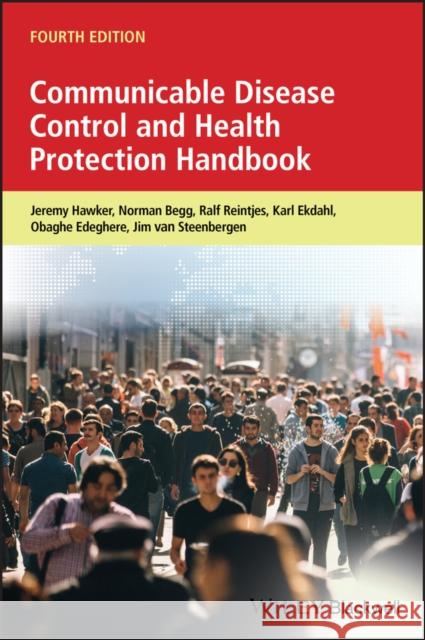Communicable Disease Control and Health Protection Handbook » książka



Communicable Disease Control and Health Protection Handbook
ISBN-13: 9781119328049 / Angielski / Miękka / 2019 / 480 str.
Communicable Disease Control and Health Protection Handbook
ISBN-13: 9781119328049 / Angielski / Miękka / 2019 / 480 str.
(netto: 302,32 VAT: 5%)
Najniższa cena z 30 dni: 314,83
ok. 30 dni roboczych.
Darmowa dostawa!
About the authors ixForeword xiAbbreviations xiiiSection 1: Introduction1.1 How to use this book 31.2 Basic concepts in the epidemiology of infectious disease 51.3 Basic concepts in the prevention of infection 81.4 Emergency risk communication 131.5 Health protection on-call 15Section 2: Common topics2.1 Meningitis and meningism 232.2 Gastrointestinal infection 262.3 Community acquired pneumonia 332.4 Rash in pregnancy 372.5 Rash and fever in children 392.6 Illness in returning travellers 412.7 Jaundice 432.8 Infection in the immunocompromised 44Section 3: Diseases3.1 Amoebic dysentery 513.2 Anthrax 523.3 Bacillus cereus 553.4 Botulism 573.5 Brucellosis 613.6 Campylobacter 633.7 Chickenpox and shingles (varicella-zoster infections) 673.8 Chikungunya 693.9 Chlamydia pneumoniae 713.10 Chlamydia trachomatis 723.11 Cholera 753.12 CJD and other human transmissible spongiform encephalopathies 773.13 Clostridium difficile 793.14 Clostridium perfringens 823.15 Coronavirus (including MERS and SARS) 843.16 Cryptosporidiosis 873.17 Cyclosporiasis 923.18 Cytomegalovirus 933.19 Dengue fever 943.20 Diphtheria 963.21 Enterococci,including Glycopeptide- Resistant Enterococci (GRE) 983.22 Enterovirus infections (including hand, foot and mouth disease) 1003.23 Epstein- Barr Virus 1033.24 Giardiasis, 1043.25 Gram-negative bacteraemia (including carbapenem-resistant enterobacteriaceae) 1063.26 Gonorrhoea, syphilis and other acute STIs 1113.27 Hantavirus infection 1183.28 Head lice 1193.29 Helicobacter pylori 1213.30 Hepatitis A 1223.31 Hepatitis B 1263.32 Hepatitis C 1293.33 Hepatitis, delta 1323.34 Hepatitis E 1323.35 Herpes simplex 1343.36 Haemophilus influenza type b (Hib) 1363.37 HIV 1383.38 Influenza 1433.39 Japanese B encephalitis 1493.40 Legionellosis 1493.41 Leprosy 1523.42 Leptospirosis 1533.43 Listeriosis 1553.44 Lyme disease 1583.45 Malaria 1603.46 Measles 1623.47 Meningococcal infection 1653.48 MRSA (Meticillin-Resistant Staphylococcus aureus) 1693.49 Mumps 1733.50 Mycoplasma pneumoniae infection 1743.51 Norovirus 1753.52 Paratyphoid fever 1793.53 Parvovirus B19 (fifth disease) 1813.54 Plague 1833.55 Pneumococcal infection 1853.56 Poliomyelitis 1883.57 Psittacosis 1903.58 Q fever 1923.59 Rabies 1953.60 Relapsing fever 1963.61 Respiratory Syncytial Virus (RSV) 1973.62 Ringworm 2003.63 Rotavirus 2043.64 Rubella 2053.65 Salmonellosis 2073.66 Scabies 2113.67 Schistosomiasis 2153.68 Shigellosis 2163.69 Shiga toxin-producing Escherichia coli (STEC) and other diarrhoeagenic E. coli 2203.70 Smallpox 2273.71 Staphylococcal food poisoning 2293.72 Streptococcal infections 2303.73 Tetanus 2333.74 Threadworms 2353.75 Tick- borne Encephalitis 2363.76 Toxocariasis 2373.77 Toxoplasmosis 2383.78 Tuberculosis (and non-tuberculous mycobacteria) 2393.79 Tularaemia 2483.80 Typhoid fever 2503.81 Vibrio parahaemolyticus infection 2533.82 Viral haemorrhagic fevers, including Ebola 2553.83 Warts and verrucae (and molluscum contagiosum) 2583.84 West Nile virus 2603.85 Whooping cough 2613.86 Yellow fever 2643.87 Yersiniosis 2653.88 Zika virus infection 2673.89 Other organisms 2703.89.1 Bacteria 2703.89.2 Rickettsia, including typhus and ehrlichia 2703.89.3 Viruses 2773.89.4 Protozoa 2773.89.5 Helminths 2823.89.6 Fungi and actinomycetes 2883.89.7 Bites, stings, and venoms 2883.89.8 Chemical food-borne illness 300Section 4: Services and organisations4.1 Surveillance of communicable disease 3054.2 Managing infectious disease incidents and outbreaks 3124.3 Community infection control 3204.4 Hospital infection control 3254.5 Antimicrobial stewardship 3314.6 Risks to and from healthcare workers 3344.7 Co-ordination of immunisation services 3384.8 Co-ordination of sexual health services 3434.9 Prevention of blood-borne viral infections 3454.10 Co-ordination of services for tuberculosis control 3504.11 Travel health 3524.12 Migrant and refugee health 3554.13 Emergency preparedness planning and response 3594.14 Non- infectious environmental hazards 3614.15 Managing acute chemical incidents 3684.16 Managing acute radiation incidents 3724.17 Deliberate release of biological, chemical or radiological hazards 3754.18 Clinical governance and audit 3844.19 Global health security 388Section 5: Communicable disease control in Europe5.1 WHO and International Health Regulations 3935.2 Collaboration within the European Union 3965.3 Detailed national example: organisational arrangements for health protection, England, 2017 3985.4 Austria 4025.5 Belgium 4035.6 Bulgaria 4055.7 Croatia 4065.8 Cyprus 4075.9 Czech Republic 4075.10 Denmark 4085.11 Estonia 4105.12 Finland 4115.13 France 4125.14 Germany 4145.15 Greece 4155.16 Hungary 4165.17 Iceland 4175.18 Ireland 4185.19 Italy 4205.20 Latvia 4215.21 Lithuania 4225.22 Luxembourg 4235.23 Malta 4245.24 The Netherlands 4255.25 Norway 4275.26 Poland 4285.27 Portugal 4295.28 Romania 4305.29 Slovakia 4325.30 Slovenia 4335.31 Spain 4345.32 Sweden 4355.33 Switzerland 4375.34 United Kingdom 438Appendix 1: Guidance documents and books 441Blood-borne viruses (BBV) 441Gastrointestinal infections 441Immunisation 442Imported infection and travel advice 442Infection control and healthcare acquired infection 443Influenza 443Legionnaires' disease 444Meningitis and meningococcal infection 444Preparedness planning 444Tuberculosis 445Vector-borne diseases 445Other 446Websites containing infectious disease guidelines 446Index 447
Jeremy Hawker Consultant Epidemiologist, Field Service, National Infection Service, Public Health England; Honorary Professor, Universities of Liverpool, Warwick, and Staffordshire, UK.Norman Begg Independent Vaccine Consultant; formerly GlaxoSmithKline Vaccines, Wavre, Belgium.Ralf Reintjes Professor, Epidemiology and Public Health Surveillance, Hamburg, Germany; Adjunct Professor, Infectious Disease Epidemiology, Tampere, Finland.Karl Ekdahl Head, Public Health Capacity and Communication Unit, European Centre for Disease Prevention and Control (ECDC), Stockholm, Sweden.Obaghe Edeghere Consultant Epidemiologist, Field Service, National Infection Service, Public Health England, UK.Jim van Steenbergen Independent Consultant; formerly Coordinator Communicable Disease Control, National Institute for Public Health and the Environment (RIVM), Bilthoven, the Netherlands.
1997-2026 DolnySlask.com Agencja Internetowa
KrainaKsiazek.PL - Księgarnia Internetowa









